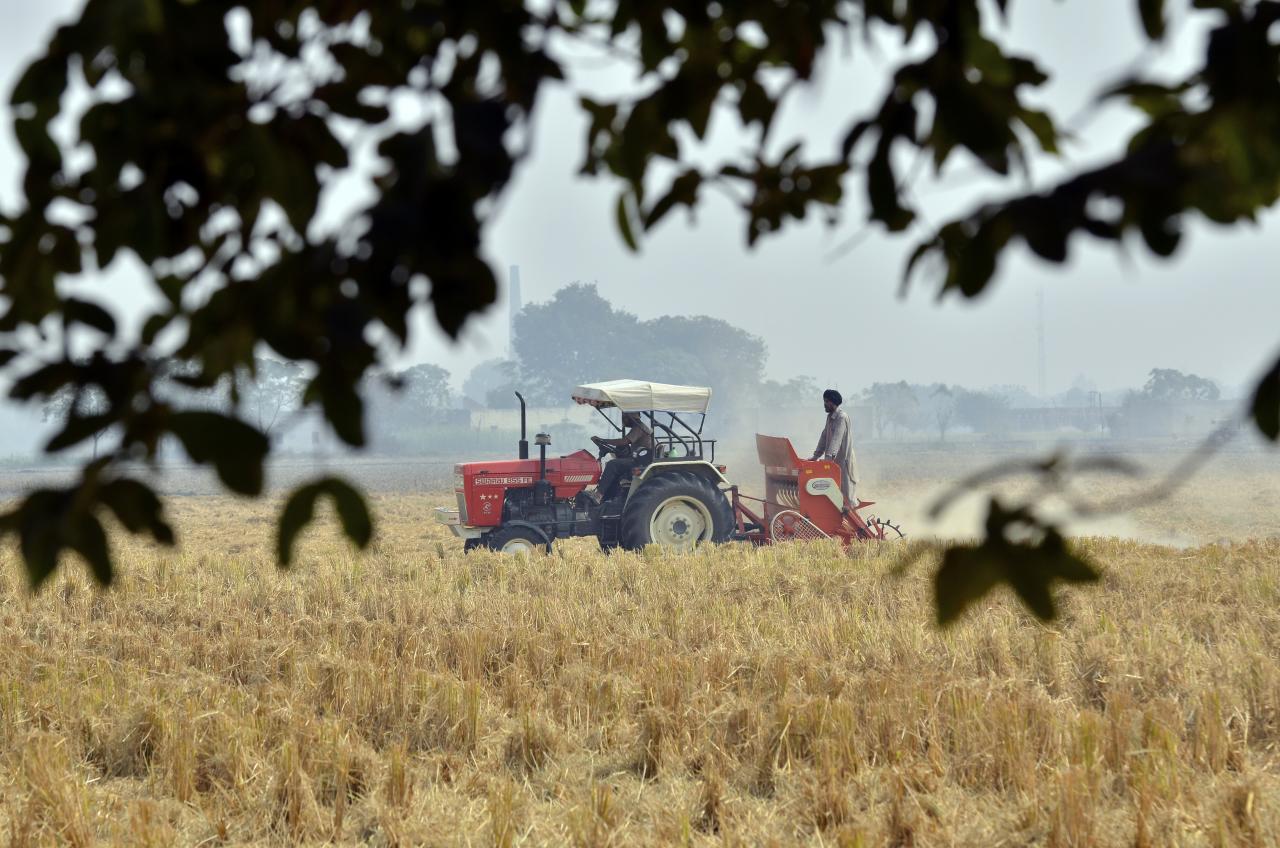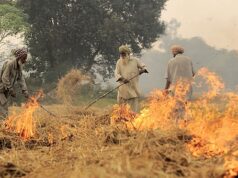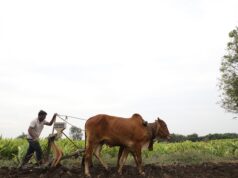This article on agricultural statesmanship by M A Venkata Rao first appeared in the Indian Libertarian, a magazine of public affairs, in April 1957. Rao’s observations about establishment of a socialist pattern of society in Indian agriculture are as valid today as they were then, only the context has changed a little.
Both in industry and agriculture, Indian policy has received a decisive orientation towards Marxism of the Soviet Russian variety since the passing of the Avadi resolution which defined national reconstruction in terms of a socialistic pattern of society. The subsequent Amritsar Congress removed the ambiguity in the phrase and equated it definitely with “socialist structure” and socialism. And now the Indore session has sought to allay the misgivings of thoughtful people by retaining the words “co-operative commonwealth” while adding “‘socialist” to the Congress creed. So the final form today is “socialist co-operative commonwealth” as regards the goal of public policy to which the country is committed by the ruling Party.
The substance of socialism contemplated is of the Russian variety beyond the shadow of a doubt. Any doubt in this respect will be dispelled by a glance at the pattern of investment built into the Second Five Year Plan with its undue stress on heavy industries and over-ambitious targets of production beyond the scope of our normal resources. The idea is to squeeze out the private sector altogether as objectionable to the socialist ideal of a classless society. The commercial and industrial class will be destroyed (non-violently in the first stage) through excessive confiscatory taxation and through narrowing its sphere through the aggrandisement of the public sector and absorbing the entire savings of the country for it through public loans.
Liquidating the Farmers
Now there are clear indications that the powers that be are contemplating a similar drive in the countryside to remove the class of independent farmers. Just as the policy in industry and commerce is to remove the class of independent entrepreneurs and property-holders, so in agriculture the policy is definitely to eliminate the land-owning peasant proprietor through the universalisation of the so-called “agricultural cooperatives.” Two Government Delegations have studied Chinese “reforms’ in agriculture both in respect of the steps taken to increase production through Government encouragement and of the measures being taken to extend “‘agricultural co-operatives” on a colossal scale. Their reports so far as they are available in the shape of press summaries are couched in terms of extravagant praise and uncritical enthusiasm, with of course a face-saving proviso that in India we should achieve similar “progress” strictly· through democratic procedures without compulsion and intimidation. The Prime Minister recently expressed annoyance with State Ministers and Congress high-ups for not daring even to put the idea of co-operatives to peasants. It is clear that after the elections (which has brought the Congress party again to power) there will be a persistent attempt made to increase the number of agricultural co-operative farms on an unprecedented scale, on the Russian and Chinese models. The country is facing a crossroads situation in agriculture as well as in industry. The industrial class has begun to realise the need for organised resistance to the perilous situation in which they find themselves largely on account of their own default and defects of leadership and character. The large class of landowners has been demoralised by the spectacle of the easy way in which the zamindari system has been abolished by the new politicians. Laws in favour of tillers enabling them to acquire property in the land they till (on behalf of owners) have been passed in some states like Bombay with its Land Tenancy Act. The next step is to deprive the new owners of the land they have recently acquired (or will acquire shortly) by herding them into agricultural “co-operative farms.” The policy has been decisively declared in the Plans.
After the Soviet Pattern
Experiment concerns only the means and pace of the “reform.” The Plans define co-operative farming as a way of farming in which peasant owners pool their lands and work under common management. Where lands are pooled under single management, the status of the participants will no longer be that of independent peasant proprietors with full property rights-to operate, sell or lease their land in accordance with their own judgement and plan of life. The peasant will become a mere labourer working on the joint or co-operative farm for hire. If the farm is managed by a committee elected by the peasants, the individual ordinary member will have no sense of participation. The chances are that the management will slip into the hands of Government-nominated party or officials as in Russia and China. In this case, even the illusion of participation on a voluntary basis will disappear and the labourer will be reduced to the position of the urban factory labourer who owns nothing but his hands. The net result will be the utter dependence of the farmer for his food and all other means of existence on the public administration. What freedom or individual initiative and personal dignity will survive under such a system can be easily imagined. And this is the shape and essence of socialism in regard to agriculture. And this is the immediate goal set before our unfortunate country by its present rulers.
Let Us Be Forewarned
And since there is no immediate prospect of changing the ruling groups, it is crucial for the welfare of ti1e country that the dangers of the policies decided upon by them should be brought home to as wide a circle of people as possible through resolute and widespread campaigns of public education conducted by all who realise the perils of the accepted programmes. While democracy is still in being by way of free public debate and a free press, opportunity should be availed of to present the other side of the shield to the general public so that the pressure of public opinion may yet occasion a halt to the disastrous courses underway and save the country from ruin in the name of the most up-to-date “progress”.
These are not merely the misgivings of libertarians like ourselves. Recognised advisers of the regime like the Radhakrishnan Commission on University Education who considered agricultural education as part of public instruction as early as 1948-49 have sounded a similar note of warning regarding the dangers of “improvisation and imitation”‘. The words are theirs-”improvising or imitation is dangerous” (page 197. University Education Commission Report). They call for statesmanship in agriculture as in other spheres of national reconstruction.
What is the difference between statesmanship and party or power politics? Mr. Cordell Hull, Secretary of State· during the entire period of the three-term Presidency of F. D. Roosevelt, twitted Anthony Eden during the last war with being only a politician while claiming that he himself was a statesman.
Statesmanship connotes long term views of the permanent interests of the nation. It consists in a vision of the potentialities of development by way of security, happiness and progress of the people and a capacity to persuade leading groups and the people at large to accept policies making for such permanent welfare lasting for generations.
Against Democratic Fundamentals
Statesmanship in agriculture called for by the University Commission requires a number of principles to be kept in view in the formulation of agricultural policies. The first concerns the goal of such policies. What is our paramount aim in agriculture? It is not enough to say that it is increased production. Increased production is necessary but it should not be achieved at the cost of human dignity and happiness and freedom. Production is not an end in itself. Enhanced production should form part of an overall way of life productive of the essentials of democratic well-being. As the Commission put it –
“India has also other needs than food. The new India has committed herself to the upholding of human freedom, to the recognition of individual worth, to the nurture of human dignity and self-respect. The food problem of India must be solved by means which are in harmony with the fundamental principles of freedom, democracy, equality and fraternity, which are the foundation stones on which the structure of the new Indian society is being built.” (Page 196. Report of the Univ. Comm. 1950).
Such ultimate views may seem to be universally accepted but there are influential groups in the country belonging to the Leftist schools of thought (of whom the Communists are the most extreme section) who are lukewarm about freedom and individuality. They are sold on socialism or collectivism with little or no place for individual freedom.
The second principle, therefore, concerns the means to be adopted to realise a free society. Leftists say that collectivism is the one and only sure path towards a. society free from exploitation and compact of human freedom-freedom from want. They say that there is no alternative to socialism or collectivism. They base themselves on the ground that laissez-faire has failed in the past and present. This assumption has to be combated through reason and analysis of examples and ideas by libertarians who have to picture an alternative system of social relations for progress and happiness on an individual basis, with such regulation as may be found to be absolutely necessary for safeguarding equality of opportunity and preventing the cancerous growth of monopoly.
Co-operative–A Deceptive Name
And in the field of agriculture, there is abundant testimony to prove the fact that co-operative farming of the variety now being proposed in barefaced imitation of the awful Russian and Chinese examples cannot lead us to the end proposed, namely; progressive production, through freedom. These co-operative farms are really a misnomer. They are truly collectives which pool the land and management of individual farmers and leave them no individual responsibility and freedom of operation. They are no more cooperatives in the true sense than “people’s democracies” are democracies in any genuine sense. Freedom is the first casualty in these “co-operative farms.”
The Report of the Indian Co-operative Union of New Delhi which has just been released (in mimeograph form) has performed a valuable service in bringing the relevant data bearing on the danger of so-called ‘cooperative farms’ to the attention of students and the administration.
Next to the question of freedom is the problem of increasing production. Why are these co-operatives advocated? Obviously on the unproven assumption that they spell scientific, planned operations on large scale units of land utilising the latest technology in tools and fertilisers resulting necessarily in enhanced rates of production. The Union’s Report brings evidence from the experience of many countries showing that cooperative farming has not resulted in any striking increment of production per unit of land and labour. Russia, China, the East European States within the Soviet orbit, Britain, the USA, Mexico are all referred to in their survey.
Agricultural Statesmanship
In the communist countries, the system of “cooperative farming has been introduced through orgies of violence and the extreme rigour of a totalitarian administration. The instinct of the peasant for ownership of the land he tills is so profound and so entwined with the heart-strings of his personality that he has resisted the deprivation of his ancestral right in an all-out manner. Stalin told Winston Churchill that the liquidation and subjugation of the peasants gave him more trouble and anxiety than the war against Nazi hordes. The intentions of our leaders seem to be to persuade the peasant’ through non-violent mean! to accept the role of a labourer in “co-operative farms”. How this is to be done passes comprehension unless under non-violent means are included the pressure of discrimination in other ways – e.g. food rations, credit facilities, seeds, prices for grain and other farm products of individualist farmers. This is being added to direct pressure and violence in China.
Warning from Russia
There is evidence that Russia has not increased her production levels in farm products since Czarist days in spite of all the development of collectives in the last thirty years.
In East European States, the same story is repeated. In the recent October Revolution of Hungary, the first thing that the farmers did was to dissolve many cooperatives and to democratise many others. Gomulka of Poland presented a devastating indictment of Russian-sponsored planning and showed that production on private farms was 30 percent greater than on cooperatives.
The assumption that collective farming will automatically increase production is thus fallacious. The increase of production that has resulted (to the extent that it has) is more due to the assistance given to the farmer and farms by way of credit, improved seeds and tools than to the formation of cooperatives. This is commented on by the Thapar report as well. The decisive factor is that of incentive but the membership of collectives offers no scope whatever for such incentive. On the contrary, it creates a sense of desolation in the peasant and takes the light out of his life.
Further, the unit of farming need not be very large for securing enhanced rates of production per unit of land and labour. The results of Japanese agriculture are impressive in this respect.
”On an average, a peasant family in Japan cultivates only 2.5 acres as compared with 3.43 acres in overcrowded Bihar. While in India 59 percent of the holdings are less than 5 acres in size, in Japan 95 per cent of the holdings are less than 5 acres and more than 40 per cent less than 1.25 acres in size. And yet the yield or paddy in Japan is 48.1 quintals per hectare as compared with 12.2 quintals in India, 28.3 quintals in the USA and 21.5 quintals in the USSR”. (A hectare is equivalent to ~2.5 acres)
The Example of India
In view of these indisputable facts and the gravity of the situation which threatens to destroy the foundations of peaceful progress in the countryside and disorganise the entire economy of the country it is essential to spread a knowledge of the crucial difference between the ethical co-operation of the Rochdale type with which the non-communist world is familiar and the collective type of farming that the communist countries favour. It is more a question of ideology than of policy based on facts and experiments.
The usual type of co-operative society is seen at its best in Denmark and the Scandinavian countries generally. Danish agriculture exhibits the highest type of progress possible consistent with the preservation of individual freedom and dignity for the peasant. The co-operatives in Denmark may be called cooperatives for betterment or specific service. They enable the individual small farmer to enjoy the benefits of large-scale operations in the matter of monetary credit, and the joint purchase and sale of his requirements and products. But in the matter of the management of his own affairs in dairy or tillage and harvesting etc. he is his own master. The co-operatives maintain standards offer scientific advice and market his products and obtain for him the latest equipment cheaply through wholesale societies. Helped in this way, the Danish farmer puts on the market more butter than the rest of the world and enjoys a standard of life as high as the workers of highly industrialised countries.
These Japanese and Danish examples are enough to show that the pooling of land and management is not necessary either for enhanced production rates or for producing a sense of well-being and freedom in the peasant.
If we are earnest with democracy and the fundamental rights, we should, as the University Commission recommended so long ago as 1949, institute a free agency for the formulation of agricultural policies based on the most reliable data obtained from all countries and tested by experiment in our own experimental farms. These policies should not be deduced by a priori logic from the accepted ideal of socialist society but should be elicited from experience and reason. They should not be adopted out of deference to the national idol–the Prime Minister who happens to have made up his mind through an uncritical absorption of Leftism in the thirties of the century under the false impression that such Leftism was the only road of progress in all sectors of life, society and State.
As the Commission puts it–”imitation is dangerous.”
Access the original text here. (page 5)
First Published in the Indian Libertarian in April 1957.
Other editions of the publication can be accessed at Indian Liberals, an open, multilingual digital archive committed to preserving liberal voices in the Indian public sphere.
Read more on the Indian liberal tradition.
Post Disclaimer
The opinions expressed in this essay are those of the authors. They do not purport to reflect the opinions or views of CCS.






